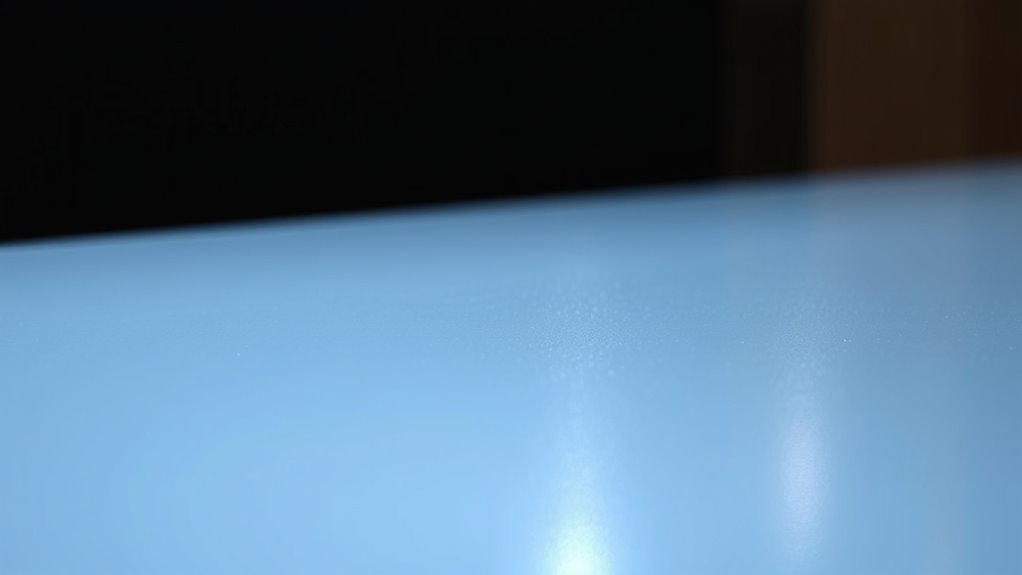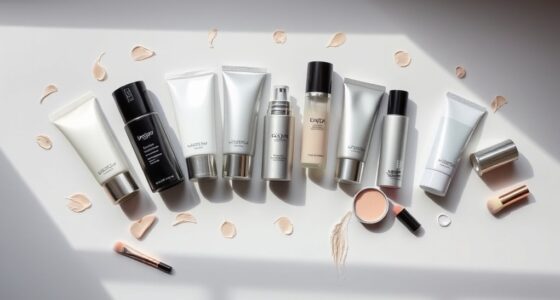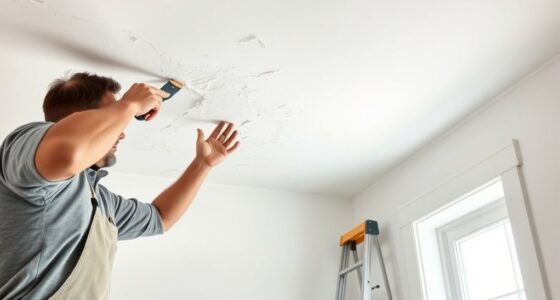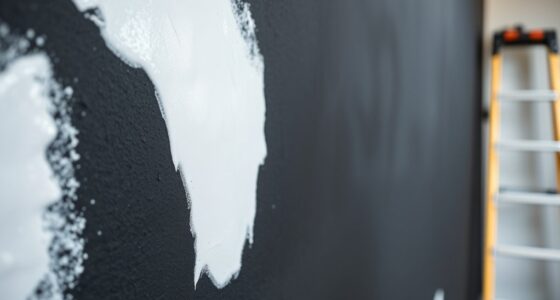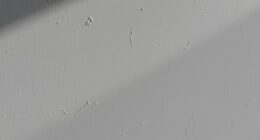Projection screen paint’s brightness and gain are key to how vibrant and clear your images will look. Brightness refers to how luminous the projected picture appears, and gain measures how much light the surface reflects back to you. Higher gain paints create brighter images but often have narrower viewing angles, while lower gain options offer more color accuracy and wider views. Understanding these basics helps you choose the right paint for your space—keep exploring to learn more.
Key Takeaways
- Brightness indicates how vivid the projected image appears; higher brightness ensures better visibility in ambient light.
- Gain measures the surface’s reflectivity; higher gain (1.8-2.0) produces brighter images but narrows viewing angles.
- Selecting the right gain depends on room lighting; high gain suits bright environments, while low gain is ideal for darker rooms.
- Proper application and finish, like matte or satin, enhance contrast and minimize glare, optimizing brightness and image quality.
- Balancing gain and brightness ensures vivid visuals with accurate colors, tailored to your projection environment.

Are you tired of expensive projector screens that take up space and limit your viewing options? If so, projection screen paint might be the game-changer you need. Unlike traditional screens, paint offers a flexible, affordable, and space-saving solution that can turn any wall into a high-quality display surface. But to get the best results, understanding brightness and gain is essential. These factors directly influence how well your projected image will perform, especially in environments with ambient lighting.
Brightness, in the context of projection, refers to how luminous your image appears on the surface. When you use projection screen paint, choosing a paint with the right gain ensures that your image remains bright and vibrant, even in well-lit rooms. Gain is a measure of reflectivity—how much light the surface reflects back to your eyes. A higher gain, such as 1.8 or 2.0, can produce a brighter picture, which is excellent if you can control the ambient lighting. However, high-gain surfaces often have narrower viewing angles, meaning the picture might look washed out if you’re not directly in front of the screen. Conversely, lower gain paints (around 0.8) provide wider viewing angles and better color accuracy, but they may not be as bright in a brightly lit room.
Higher gain paints deliver brighter images but with narrower viewing angles, while lower gain options offer wider views and better color accuracy.
When selecting projection screen paint, consider your room’s ambient lighting. If your space has a lot of windows or overhead lights, you’ll want a paint with a higher gain to compensate for the extra light. Conversely, if your environment is darker or you can control the lighting, a lower gain paint will deliver better color accuracy and deeper blacks. The key is balancing brightness with color fidelity. Brightness ensures that images are vivid, while good color accuracy maintains the richness of your visuals, avoiding washed-out or dull colors.
Applying the right paint with the appropriate gain can transform your wall into a projector-friendly surface with excellent contrast and clarity. Remember, the finish of the paint also matters—matte or satin finishes help minimize glare and hotspots, preserving a consistent picture. Ultimately, understanding how gain influences brightness and how ambient lighting affects image quality helps you make an informed choice. With the right projection screen paint, you’ll enjoy a crisp, bright, and color-accurate display that adapts to your room’s lighting conditions, all without the cost and space of a traditional projector screen.
Frequently Asked Questions
How Does Ambient Light Affect Projection Screen Paint Brightness?
Ambient light interference can notably reduce the perceived brightness of your projection screen paint, making images look washed out. To achieve ideal screen brightness, you should minimize ambient light sources and consider paint with higher gain for better reflectivity. Properly controlling ambient light helps with screen brightness optimization, ensuring your projected images stay vibrant and clear, even in well-lit rooms. This way, you get the best possible viewing experience.
Can Projection Screen Paint Be Used Outdoors?
Using projection screen paint outdoors is like painting a canvas for the sky. You can definitely do an outdoor installation, but choose a weather-resistant type designed to withstand rain, sun, and humidity. These paints are formulated for durability, ensuring your screen stays vibrant and functional. Just remember, outdoor conditions can challenge brightness and image quality, so pick a high-gain, weather-resistant paint for the best results.
Is There a Difference Between Matte and Gloss Projection Paints?
Yes, there’s a difference between matte finish and gloss finish projection paints. Matte finish paint absorbs light, reducing glare and making images clearer, especially in bright rooms or outdoor settings. Gloss finish, on the other hand, reflects more light, which can enhance brightness and contrast but may cause glare and reflections. Choose matte for softer, glare-free visuals, and gloss if you want a brighter, more vibrant picture.
How Durable Is Projection Screen Paint Over Time?
Your projection screen paint can last years if you choose high-quality options. Its durability depends on factors like paint adhesion and exposure to sunlight, which can cause color fading over time. With proper application and a protective coat, the paint resists peeling and maintains brightness. Think of it as a lasting canvas that keeps your images vivid, even as the years go by, making your investment worthwhile.
What Cleaning Methods Are Recommended for Painted Projection Surfaces?
You should use gentle cleaning techniques for your painted projection surface. Start with a soft microfiber cloth dampened with water or mild soap, avoiding harsh chemicals. Before cleaning, surface preparation is key—test a small area first. Avoid abrasive scrubbers or strong cleaners that could damage the paint. Regular, careful cleaning helps maintain brightness and prevents buildup, ensuring your projection surface stays in top condition for ideal image quality.
Conclusion
Now that you understand the basics of brightness and gain, choosing the right projection screen paint is like finding the perfect pair of sunglasses—you want clarity without glare. Remember, higher gain isn’t always better; it’s about balancing brightness with image quality. With this knowledge, you’re ready to transform any wall into a cinematic canvas. So go ahead, paint your way to a brighter, sharper viewing experience—your home theater’s shining future awaits!
